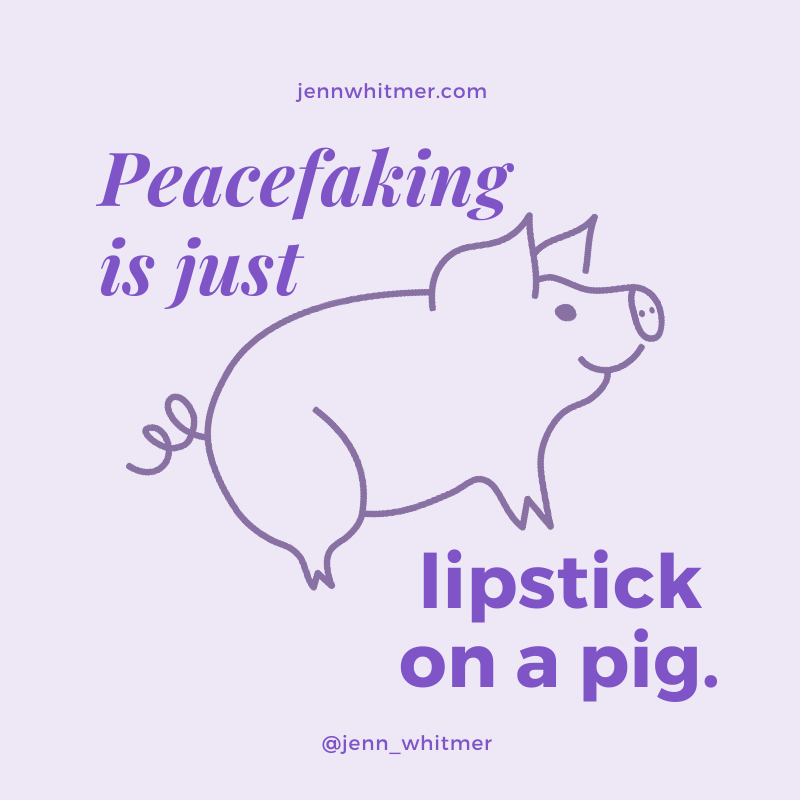Peacefaking doesn’t resolve a conflict.
Imperfect people, all seeing the world differently, try to make their way in the world together…well, conflict happens.
Some of you see conflict coming, and you are Audi 5000.
Some of you are just as conflict-avoidant, and you may say:
“Oh, I never fight with people.”
“I just turn the other cheek.”
“I keep the peace.”
“I’m above all the drama.”
Today, I’m talking to you. My friends who are ready for flight mode when you sense disagreement or discord.
I have a truth for you. One that may ruffle your feathers a little.
Keeping the peace by avoiding conflict results in deeper and bigger conflicts.
You cobble together a fake peace that slowly causes a war—usually with yourself.
Peacefaking responses are just mock-ups of peace, which is no peace at all. Peace-faking is putting lipstick on a pig. Dressing it up doesn’t change it from squealing around in the background of your life, wreaking havoc on peace.
Six examples of unhealthy conflict avoidance responses:
DENY
On the outside: Oh, it’s no big deal. Not a problem.
Inside: This is the third time he’s been late to a meeting. With no apology. Ugh, I can’t say anything. It’s just how it is.
Denying the issue doesn’t bring any peace or resolution to a situation. One person is unaware. The other gets bitter.
AVOID
Oh, I’m not going to say anything. It will just get better.
Conflict has inertia. Unless acted upon, it just continues in the same direction.
APPEASE
Sure. I can do that for you.
Taking responsibility for what is not yours to do feeds boundary-breakers. If you keep rewarding poor behavior, it just gets worse.
BLAME
It’s their fault. I have nothing to do with this.
I am a huge proponent of healthy boundaries, but blaming others isn’t it. Conflicts are rarely 50/50. But whatever the percentage breakdown is, you are 100% responsible for your part.
SELF-HARM
When blame turns toxic and inward, self-harm is the most intense form of flight. Getting out of the conflict in the most extreme way.
The great news: We can change our responses to conflict.
Healthy responses save relationships, build trust, and spread peace. Responses to stop that pig from squealing.
Overlook
I described overlooking in more detail in this post. In general, overlooking engages our empathy for the other person. Internally, we make the conscious choice to forgive and move on. Most conflicts end here, in your own mind.
Confront
Confrontation done well raises a concern kindly and directly. When deciding to confront another person, I’ve found this three-part framework helpful. One, the offense doesn’t create a wall between the other person and me for more than a short period of time. The closer the relationship, the shorter time. Two, the offense doesn’t cause serious harm to others, the offender, or me. Three, the offense is singular, not part of a pattern of behavior.
At times, you may have to confront yourself about the hurt you’ve caused. If you’ve realized you’ve hurt someone, you should initiate a conversation to admit the pain you’ve caused and sincerely apologize.
Confrontation involves a wide variety of approaches. It isn’t, “Dude, here’s why you’re wrong.” It’s questions, discovery, honesty, and more. The goal of confrontation is restoration of relationship.
Discussion
Discussion is working together to negotiate an agreeable solution to the issue. Listening, repeating back what you’ve heard, offering options, accepting options are all part of working together to resolve the conflict and maintain a healthy relationship. Discussion is coming together to find what’s right for everyone.
Mediation
Sometimes, we need a translator. Some situations just become frozen and need a warm spring breeze to help the thaw. A mediator helps reconcile and negotiate between people. A mediator can be as simple as a mutual friend or as formal as a professional conciliator. This is a positive step, not a sign of failure! Engaging a mediator means both parties are accepting the reality that this discussion isn’t coming to a solution without some help.
Arbitration
All parties agree the conflict is at an impasse. Arbitration brings in a neutral part to listen to all the information and make a decision. Everyone agrees to the resolution the arbiter makes. Do you know the famous story of Solomon listening to the sad case of two women and two babies?
Two women were in a fight for their lives that also sounded like a sandbox dispute of “No, it’s mine.” With no resolution in sight, the women went before the king to arbitrate their conflict. Solomon astutely judged the real mother would save her child’s life regardless of the cost. So, after threatening to divide the baby—literally—between the two women, the real mother was plain and restored to her baby.
The two mothers’ story illustrates why arbitration is more intense than a mediator, and why wisdom in your chosen arbiter is essential. Otherwise, the outcome could be far worse than ending up in a ditch.
Accountability
A governing body—your leadership, your faith community, your management team, or another authority—puts a framework in place to restore a relationship to health. It’s a little bit like a brace after a cast comes off. Some issues require clear and firm guidelines to keep things moving in the right direction on the path to sustained health.
We cannot walk through life without conflict. These tools offer you a way out of your initial flight pigpen, onto the road of healthy responses.These six healthy categories of responses to conflict were established by Ken Sande in his book, The Peacemaker.

COMMENTs:
0